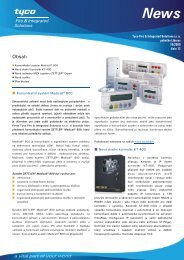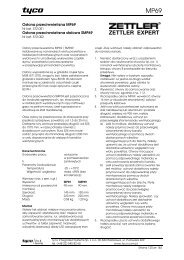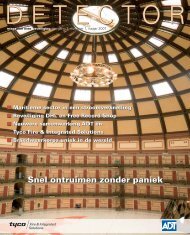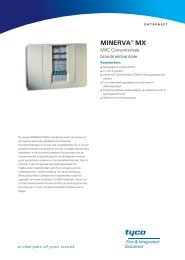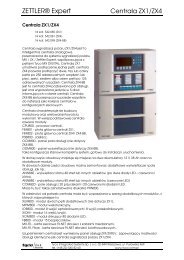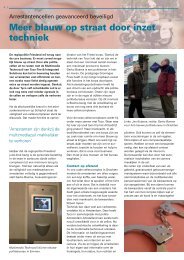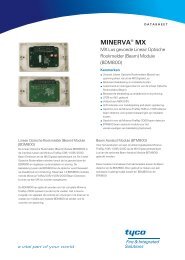C-CURE Product Catalogue Issue 1
C-CURE Product Catalogue Issue 1
C-CURE Product Catalogue Issue 1
Create successful ePaper yourself
Turn your PDF publications into a flip-book with our unique Google optimized e-Paper software.
Glossary of Terms<br />
Access Group Permission programmed into the access control system to<br />
allow a cardholder to enter certain doors at specified times.<br />
Active Card An access control proximity card, which is powered by a battery<br />
within the tag or keyfob. Be aware that batteries have a limited life span<br />
and in most cases cannot be replaced - hence the customer will need to<br />
budget for replacement within the life expectancy of the system.<br />
Anti-Pass Back (APB) is a facility where card readers are programmed as<br />
IN or OUT of a controlled area. Cardholders can enter and area BUT the<br />
card cannot be used at any other IN reader until the card is “seen” by the<br />
system to leave the area. This stops duplicate use of a card at controlled<br />
points.<br />
Asset Tagging Usually managed by active tags and long range<br />
readers/door loops. Asset tagging provides tags, which are suitable for<br />
fixing to items such as laptops, projectors etc. Tags can be static (for fixed<br />
location items - works of art) or portable. Some have additional features<br />
such as tamper, so that the tag cannot be removed whist within the secure<br />
area before the item is taken off site.<br />
Barcode Low cost and low security means of providing access control.<br />
Commonly seen in libraries,. Two methods of barcode are available - open<br />
(as seen in library books) which can be copied and reproduced giving no<br />
security at all and Obscure, which has a panel over the barcode stopping<br />
copying.<br />
Biometric Reader Uses a part of the human body to identify the user -<br />
fingerprint retina scanner etc. Most give a Wiegand output and can be<br />
integrated with our systems subject to test.<br />
Card Number<br />
This is the internal encoded number - as read by the system<br />
Cashless vending A third party supplied system that allows the employee<br />
to use their access control card to purchase lunch, coffee etc. Smart cards<br />
are now being promoted for this purpose. Older systems use track 3 of the<br />
magstripe - only high output mag-stripe tape is accepted by some suppliers<br />
of cashless vending i.e. Girovend.<br />
Clock & Data A card format usually associated with magstripe. This can<br />
however be reproduced by proximity and other reader types.<br />
Coercivity This is the term for the resilience of a magstripe. Standard<br />
access control cards are Hi Co whist Bankcards are usually Lo Co.<br />
Domain software Excelsior’s software package allowing up to 8 networks<br />
to be controlled from one PC. The main advantage of using Domain would<br />
be the use of names for card holders, doors, readers, time zones etc AND<br />
the archiving of al transactions for historical and audit reporting of who went<br />
where and when etc.<br />
Dongle Provided with SGA & Domain software to stop software from being<br />
duplicated for use on other sites.<br />
Door Forced this is an alarm generated by the access system when the<br />
door is opened by unauthorised means break glass box, door override<br />
switch or forced entry. Door must be fitted with a monitor contact.<br />
Door Held Open Alarm generated when an access controlled door is<br />
wedged in the open position after being opened by authorised means. Door<br />
must be fitted with a door contact. Some systems offer local alarm feature<br />
prior to a full alarm at a central location.<br />
Door Loop (reader) This is a cable placed around the doorframe, within the<br />
floor or ceiling to create a larger aerial for a proximity reader. Used for<br />
Hands free access and/or asset tagging.<br />
doors hinged edge to transfer power and monitoring to a lock or electric<br />
release.<br />
Duress Code/PIN By changing the PIN code used by the authorised person<br />
to enter the site. An alarm may be generated at a central location identifying<br />
that the user has gained access whilst under duress. Access at the<br />
door is gained without any local alarm being generated.<br />
Ethernet The most popular standard for networking information technology<br />
equipment. Devices are addressed using TCP/IP protocol.<br />
ECC Ethernet Comms Convertor. Used by SGA to connect a network of<br />
controllers to the central PC via either a dedicated LAN or customers<br />
LAN/WAN. The ECC provides the RS422 protocol required for the SGA<br />
comms line.<br />
Excelsior Tyco manufactured access control system. Can be managed by<br />
either hand held programmer or Domain software. Up to 8,000 cardholders<br />
and from 1 to 1,008 readers. Controllers can be connected by hard-wired<br />
connection, fibre, LAN/WAN or dial-up/dedicated telephone line.<br />
Fail-Safe Term for a lock that requires power to lock - power fail releases<br />
the door. Not suitable for perimeter doors. Ideal for fire exit routes as a fire<br />
alarm input and breakglass box can release the door to meet fire officers<br />
requirements. All face to face mag locks are fail safe. Not suitable for very<br />
secure areas.<br />
Fail-Secure Term for a lock that requires power to operate and allow the<br />
door to be opened. Motor locks and solenoid bolts are typical examples.<br />
Mechanical override is required for means of escape to meet the fire officer’s<br />
requirements.<br />
Graphics Available on SGA. Customers site drawing are either produced<br />
or taken from CAD file. SGA uses bitmap files for Graphic maps - which can<br />
be site photos etc. Icons can then be added for monitored/controlled points,<br />
which are animated to show their status.<br />
Hall Effect Monitoring built in to some magnetic locks to ensure that the<br />
holding force is up to the specified levels. Provides monitoring to overcome<br />
the typical methods of reducing holding force - grease, film etc - making<br />
forced entry much easier.<br />
Hands Free The use of long range readers/Door loops with active tags to<br />
monitor the movement of personnel and assets.<br />
Hi Co Type of magnetic stripe tape - see Coercivity<br />
IAC Intelligent Access Controller for SGA. Supports two card readers (with<br />
or without keypads) and all necessary inputs/outputs for monitoring etc.<br />
Auxiliary inputs and outputs for local devices are also provided. The controller<br />
is boxed with power supply and tamper feature as standard.<br />
Controller will support 12,000 or 44,000 cardholders.<br />
IOC Input Output controller for SGA. Provides supervised input monitoring<br />
and clean contact outputs for local alarm management of non-access control<br />
devices.<br />
ioPass Tyco manufactured standalone proximity access control system.<br />
Supports up to 5,000 card users. Full compatibility with ioProx readers.<br />
ioProx Tyco manufactured range of proximity cards and readers. Can be<br />
used with SGA and with correct firmware Excelsior. Readers are formatted<br />
and the correct items must be ordered. Unique format for ADT/Tyco businesses.<br />
Door Loop (for lock) Flexible conduit either surface or concealed at the<br />
60




